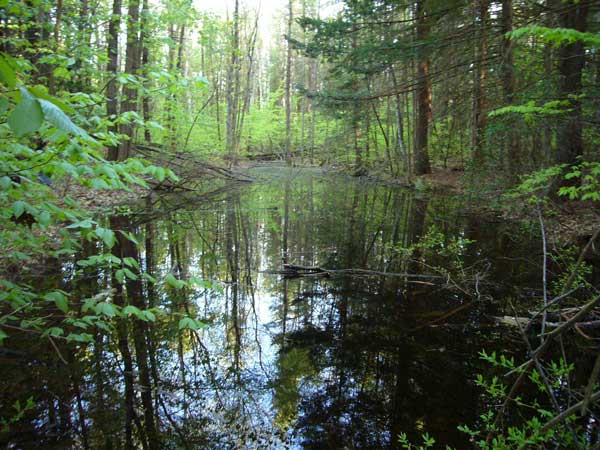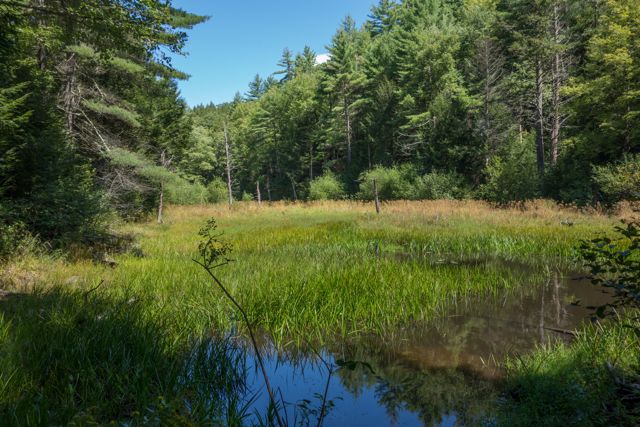
Vernal Pool, Warwick State Forest - Photo by B. Compton

Vernal Pool, Warwick State Forest - Photo by B. Compton
The Conservation Commission is still looking for a seventh member. Our meetings are typically the first Monday of the month at 7:00 pm and are open to the public. Feel free to come and sit through a meeting if you think you might be interested.
Just a reminder that if you are planning to work in or near wetland resources, you need to contact and perhaps file with the Con Com first. If you have any questions about whether the area you are planning to work in is jurisdictional or not, call someone from the Commission to take a look at it. All areas within 200 feet of streams and rivers are jurisdictional and there should be no cutting of trees or other vegetation or land-moving activities without a permit in these areas.
Please keep the suggestions of hikes you would like to see coming! I have received lots of great suggestions and we are working our way through them. We also have had some questions raised - When were the red pine plantations planted near Bass Swamp and who planted them?
Finally, the Conservation Commission is moving our monthly meetings to the first Monday of the month as this will work better for some of our members. If you are filing a Request of Determination for Applicability or a Notice of Intent, please make sure we have it about 2 weeks in advance so that the legal notice can be in the newspaper at least 5 business days in advance.
Thanks, I hope to see many people at one or more of these events! We have had great turnouts so far!
The Commission usually meets on the first Monday of each month at 7:00 p.m.
To schedule a site visit regarding an application for a Building Permit please call Gregory Brodski or Christine Duerring. To receive an application form for a permit to do work in a wetland resource area or buffer zone, download from this site (see below) or call Mary Williamson.
Please file forms with the Conservation Commission at least *two weeks* before a meeting date to allow time to publish notice of the hearing, as required by law. Please notify Mary Williamson by phone, (978) 544-7133, when you've submitted your application.
The Warwick Conservation Commission administers the Massachusetts Wetlands Protection Act and related regulations. The Commission has the authority to regulate activities in the "buffer zone" of upland that is within 100 feet of a wetland or stream, and the "riverfront area" within 200 feet of perennial rivers or streams. If you are planning any landscaping, clearing, filling, excavation, demolition, or construction within a wetland or floodplain, within the 100' buffer zone, or within 200' of any river or other perennial stream -- whether or not the wetland resource is on your property -- or if you are unsure if your project lies within a wetland resource area, please contact the Conservation Commission before you begin your project to determine if you will need a permit.
Building permits will not be issued by the building inspector until first signed off by two members of the Conservation Commission.
The Commission will be pleased to help you determine the procedures that are applicable to your proposed activities and to work with you in order to best protect the wetland resource areas. Work done without a permit is subject to an Enforcement Order, which may include fines.
The general rule for wetlands is "no alteration." This sounds fairly straightforward when we think of activities that obviously change the nature of wetlands, such as dredging or filling or building directly in the wetland. However other activities that we may not immediately perceive as "alteration" can be detrimental to the health and function of wetland resources and, therefore, are prohibited in wetlands. Activities in the 100 foot Buffer Zone and 200 foot Riverfront Areas also fall under Conservation Commission jurisdiction, enabling the Commission to require that steps be taken to minimize the threat of adverse wetland impacts when construction and other work in the upland occurs.
The Massachusetts Wetlands Protection Act and Regulations are administered by the Warwick Conservation Commission in order to ensure that no harm is done to the wetlands or to their ability to protect public and private water supply, protect groundwater, protect water quality, prevent flooding and storm damage, and protect wildlife, wildlife habitat, and fisheries (the "public interests"). If you are planning any work within a wetland resource area or buffer zone, you will need to apply for and obtain a permit. If the buffer zone activity you plan is relatively minor, it may not require a permit, and you may request a determination of applicability.
Request for Determination of Applicability (RDA): a request that the Conservation Commission determine if the work proposed requires a permit (some minor activities, such as small alterations of the buffer zone more than 50 feet from a wetland may not require a permit) or that the Commission determine if the work is within a Resource Area.
WPA Form 1: Request for Determination of Applicability: http://www.mass.gov/eea/agencies/massdep/service/approvals/wpa-form-1.htmlAbbreviated Notice of Resource Area Delineation (ANRAD): an application to request that the Commission formally review and approve the delineation of resource areas at a site. This form also includes simplified review of work in the Buffer Zone on relatively level properties (not the typical situation in Warwick, but there are some).
WPA Form 4A: Abbreviated Notice of Resource Area Delineation: http://www.mass.gov/eea/agencies/massdep/service/approvals/wpa-form-4a.htmlNotice of Intent (NOI): an application to request that the Commission approve work within the buffer zone or another resource area.
WPA Form 3: Notice of Intent: http://www.mass.gov/eea/agencies/massdep/service/approvals/wpa-form-3.htmlRequest for Certificate of Compliance: A Certificate of Compliance is issued upon full or partial completion of work authorized in an Order of Conditions, or if the work never commenced and a new Notice of Intent and Order of Conditions are required.
http://www.mass.gov/eea/docs/dep/water/approvals/year-thru-alpha/w/wpafrm8b.docExtension Permit for an Order of Conditions. An Order of Conditions is valid for three years from the date of issuance. If an extension is needed, the applicant must submit a written request for the extension to the Conservation Commission at least 30 days prior to the expiration date of the Order of Conditions.
Wetland Resource Areas include:
A good regulatory definition of the term "wetland" may be found in the Federal Clean Water Act:

Hodge Brook Beaver Meadow, Arthur Iversen Conservation Area - Photo by B. Compton
Those areas that are inundated or saturated by surface or ground water at a frequency and duration sufficient to support, and that under normal circumstances do support, a prevalence of vegetation typically adapted for life in saturated soil conditions.
As such, wetlands are defined -- or delineated -- according to three criteria: